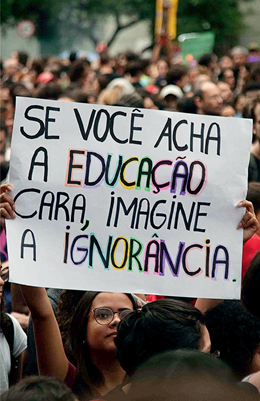by José Eustáquio Diniz Alves
Translated by Lucas Thixbai Freitas Reviewed by Matheus Lucas Hebling
Originally published in Portuguese May 11, 2020 link
Annual GDP growth rates per capita and 10-year moving average, Brazil: 1900-2020

The COVID-19 pandemic arrived in Brazil with some delay, but with disproportionate force, due to the inability of the public power to come up with an effective response to contain the spread of the coronavirus.
According to data from Johns Hopkins University, on March 1st the world reached 88,600 infected people and 3,000 deaths, while Brazil had only 2 cases and the first death occurred on March 17th. On April 2nd, the world reached 1 million cases, and 53 thousand deaths and Brazil reached 7.9 thousand cases (0.8% of the global total) and 299 deaths (0.6% of the total). On April 15th, the world reached 2 million cases and 135 thousand deaths and Brazil presented 28.3 thousand cases (1.4% of the global total) and 1.7 thousand deaths (1.3% of the total). Eleven days later, on April 26th, the world reached 3 million cases and 207 thousand deaths, while Brazil reached 61.9 thousand cases (2.1% of the global total) and 4.2 thousand deaths (2% of the total).
Therefore, COVID-19 grows faster in Brazil than in the world average and it is a mistake to consider that the country “performs” well, as said the proud doctor Nelson Teich, currently responsible for the Brazilian Ministry of Health. Exchanges of ministers and political instability in the country only make it difficult to control the pandemic emergency and Brazil has one of the highest growth rates of the disease in the world. In the global ranking, by the end of May, Bolsonaro’s country should only lag behind Trump’s the United States.
The COVID-19 pandemic could not reach Brazil at a worse time. The Brazilian economy was already weakened, with “multiple sclerosis” and several risky “diseases”, such as low productivity, low international competitiveness, low dynamism in the production of goods and services, low generation of decent jobs, low-income generation, low investment and with “high pressure” on the fiscal deficit, public debt and indicators of poverty and social inequality.
Since the 1980s, Brazil has been on a submerging path, growing less than the world average. Until the beginning of this year, the Brazilian economic performance in the current decade (2011-2020) was tied with the performance of the 1980s, and the country was moving towards the second lost decade. But the report of the International Monetary Fund (IMF), released on April 14, estimates that the Brazilian Gross Domestic Product (GDP) will fall 5.3% in 2020 (there is a possibility that the fall will be even greater). If this estimate is confirmed, Brazil will have its biggest annual recession since 1900 and have the worst economic decade in its history, as shown in the graph that illustrates this article.
The social impacts will be dramatic. There is no space, in this brief text, to take an inventory of the tragedy. For this reason, we will focus only on the labor market, which is an area that has been suffering a lot since 2014, and which is essential for the country’s future.
According to the General Register of Employed and Unemployed (CAGED, maintained by the Brazilian Institute of Geography and Statistics, IBGE), of the Ministry of Labor, shortly after the 2014 presidential elections, the country had 41.3 million formal jobs in November 2014; this number fell in 2015 and 2016 and recovered partly in the following years, but reached only 39 million jobs in December 2019. Therefore, there is a deficit of 2.3 million formal jobs, compared to 5 years ago behind.
The latest data from the continuous PNAD (national research effort to monitor fluctuations in the short, medium, and long terms, of socioeconomic information, such as employment and wages), from IBGE, show a not very encouraging picture of the level of employment in Brazil. Information referring to the quarter of December 2019 to February 2020 indicates that the country has a low insertion of its inhabitants in the labor force and there is a great waste of the national productive potential:
● Brazilian population = 210.3 million people
● Employed population (formal + informal employment) = 93.7 million people
● Total unoccupied population = 116.9 million people
In other words, most of the Brazilian population (55%) was not employed in the last quarter of the survey and only 45% of the population had an occupation. Among the employed, there was an informality rate of 40.6%, meaning a contingent of 38 million employed persons, but without formal employment ties and social protection. The unemployed population was 12.3 million people and the underutilized population was 26.8 million people. In Brazil, there are many more “effective consumers” than “effective producers”, unlike, for example, China and Vietnam.
We are not going to refer to Marx’s theory of value, lest we are accused of spreading “cultural Marxism”. But suffice it to quote Adam Smith, who in the first sentence of his famous book, from 1776, says: “The annual work of each nation constitutes the fund that originally provides it with all the necessary goods and the material comforts it consumes annually”. In other words, work is the source of all a country’s wealth.
And then we get to demographics. Brazil, between 2015 and 2020, is experiencing its best demographic moment. Emphasizing: the best moment of all time, whether from the past or the future. We are in a singular moment, which only happens once in the history of any country. It is when the proportion of people of working age is at its peak and the proportion of people of non-productive or less productive age (children and the elderly) is at its lowest point. Known as the “demographic bonus”, this special event is that event essential for the take-off of any country’s socio-economic development. There is no nation with a very high Human Development Index (HDI) that has not taken advantage of the opportunities of a low ratio of demographic dependence.
Well, taking advantage of the window of opportunity is essential for social progress and this would only be possible with investments in the employability of the workforce, with health and high educational qualifications. However, this is not what has happened in Brazil in the last 6 years of high rates of unemployment and underemployment, of increasing poverty and inequality and of dismantling any perspective of a broader social protection system.
With the epidemic outbreak, of immeasurable results, which was bad, it got much worse. If the possibility of a synergy between the economy and demography already faced almost insurmountable structural obstacles, now the situation is aggravated by the disjunctions generated by social isolation.
So, if nothing is done to reverse the Brazilian economic and social crisis – which has persisted since the penultimate presidential election, in 2014 – the COVID-19 pandemic could be the shovel in the dream of taking advantage of the “demographic bonus”, implement the banner of “Full employment and decent work” and implement the goal of ending poverty and the goal of full social equity.
The current adversities may be the burial of the fundamental idea of emancipation through work and the right to productive self-determination. Anyway, it could be the end of the dream of a free, democratic, sovereign, and prosperous nation.
José Eustáquio Diniz Alves is a sociologist, doctor in demography, an ENCE / IBGE retired professor and a contributor to the Ecodebate and #Colabora websites








